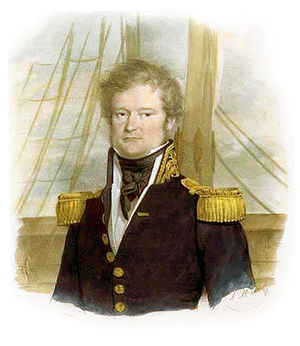Dumont d'Urville, Jules
| Topics: |
Jules Sebastian Cesar Dumont d'Urville (1790-1842) was a French explorer who contributed to the exploration of the Antarctic and other regions.
D'Urville joined the navy at seventeen, but obtained little actual sea experience because of the dominance of the British navy which was at war with {C}{C}France and maintained an effective blockade. In 1814, d'Urville participated in an surveying expedition in the Mediterranean which resulted in papers published by him on several areas of natural science and archeology. In 1820, while participating in a survey of Greek Islands, d'Urville was offered a statue for sale by a Greek peasant. Though damaged during the transaction, during which the arms were lost, d'Urville was able to bring about the acquisition of the statue, to be named the Venus d'Milo, for which he was awarded the Legion d'Honneur and promotion to Lieutenant.
In 1822, d'Urville participated in a three-year expedition to the Pacific during which he was in charge of much of the scientific work on plants and animals. The expedition stopped in the Falkland Islands, Chile, Peru, various Pacific Islands, New Zealand, Australia and New Guinea and returned with several thousand species of plants and insects, many previously unknown.
In April, 1826, d'Urville, promoted to commander, led another three-year expedition to the Pacific which again yielded a significant collection of samples and scientific work which was published between 1832-4. The expedition visited Australia, New Zealand, Tonga, Fiji, New Caledonia,[[Guinea, Soloman Islands, Caroline Islands and the Moluccas.
In early 1837, d'Urville proposed an expedition to {C}{C}Oceania, which was modified by {C}{C}King Louis Phillippe to include the goal of exceeding the {C}{C}Farthest South record of {C}{C}James Weddell (set in 1823) and even a possible bid for reaching the [../156138/index.html South Pole]]. D'Urville sailed in command of two ships, the Astrolabe and the Zélée, in September 1837. At the end of January, 1838 the expedition tried to follow Weddell's course south but soon ran into pack ice which eventually trapped the ships which prevented them from even reaching the Antarctic Circle. Getting free of the ice, the expedition charted part of the north east of the Antarctic Peninsula (now known as the Trinity Peninsula which was named by d'Urville Louis Philippe Land).
The expedition spent March 1838 - December 1839 in the Pacific and East Indies, including a visit to the Marquesas Islands. In Hobart, Tasmaina, d'Urville met John Biscoe a sealer who, in 1830-32, had circumnavigated the globe at high southern latitudes. Biscoe charted a region of coast south of the Indian Ocean, which he named Enderby Land, and various islands off the coast of the Antarctic Peninsula.
D'Urville's plan was to sail near due south from Tasmania toward the magnetic south pole taking magnetic measurements and to see if a path to a new Farthest South position could be found. However, as the expedition entered the Antarctic Circle at about 136oE on January 19, 1840, a mountainous coast was sighted and named Terra Adelie or the Adelie Coast, after d'Urville's wife. A landing was made on offshore isles and rock samples were collected. On January 29, the expedition sighted a ship of the American expedition led by James Wilkes, but confusion between the ships resulted in non-communication. The expedition continued to track a high ice cliff at 133oE which was interpreted as surmounting land and named the Claire Coast after the wife of d'Urville's second-in-command Charles Jacquinot. The expedition took magnetic measurements throughout in order to locate an accurate position for the magnetic south pole. On February 1, d'Urville turned north and returned to Tasmania. Following a stop on the Auckland Islands and New Zealand, the expedition returned to France in November 1840.
In May 1842, d'Urville and his family were killed in a train accident.
A French Dumont d'Urville Antarctic Research Station is named in his honor.
Further Reading:
- An Account in Two Volumes of Two Voyages to the South Seas by Captain (later Rear-Admiral) Jules S-C Dumont D'Urville of the French Navy to Australia, New Zealand, Oceania, 1826-1829 in the Corvette Astrolabe and to the Straits of Magellan, Chile, Oceania, South East Asia, Australia, Antarctica ...By Jules-Sébastien-César Dumont d'Urville, (Translated by Helen Rosenman), University of Hawaii Press, 1993 ISBN: 0824815106.South Pole: A Narrative History of the Exploration of Antarctica by Anthony Brandt, NG Adventure Classics, 2004ISBN: 0792267974.
- The Race to the White Continent, Alan Gurney, W.W. Norton and Company, 2002 ISBN: 0393323218.
- A Voyage Of Discovery And Research In The Southern And Antarctic Regions V1: During The Years 1839-43, James Clark Ross, 1947, ISBN: 1436997704.
- Voyage of the U.S. Exploring Squadron Commanded By Captain Charles Wilkes of the United States Navy in 1838, 1839, 1840, 1841, and 1842: Together with Explorations & Discoveries Made By Admiral D'Urville, Captain Ross, & Other Navigators & Travellors, John S. Jenkins, Burnett & Bostwick, 1854
- Exploring Polar Frontiers: An Historical Encyclopedia, William James Mills, ABC-CLIO, 2003 ISBN: 1576074226.
- Jules Sebastien Cesar Durmont d'Urville South Pole.com (accessed January 3, 2009)
